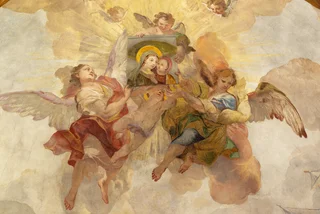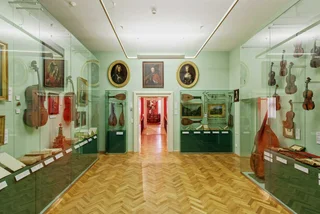A part of the remains of the last Czech king was placed in the Imperial Chapel in St. Vitus’ Cathedral at Prague Castle on Sunday following a mass celebrated by Bishop Václav Malý. The king died 100 years ago this month, though his reign ended with the collapse of the Austro-Hungarian Empire at the end of World War I.
While people tend to associate Czech kings with medieval history, the monarchy technically lasted until 1918. There is still a political movement to restore the Czech throne, but so far it hasn't yet managed to get much support for the idea of restoring a king to Prague Castle.
Emperor Karl I of Austria also reigned as King Karel III (Charles III) of Bohemia from 1916 until the start of the First Republic of Czechoslovakia in 1918. Due to the political climate of the time, a coronation ceremony was never held in Prague, though there was a ceremony in Budapest where he became king of Hungary. He never officially renounced any of his titles and died in exile in Madeira on April 1, 1922, at the age of 34.

Bohemia had another royal Karel, revered Emperor Karel IV (Charles IV), in the 1300s, which makes the numbering of monarchs a bit confusing. He was the fourth emperor of the Holy Roman Empire to be named some version of “Charles,” but was actually the first king of Bohemia to bear that name and was technically King Karel I of Bohemia. There was a King Karel II of Bohemia in the 1700s, which makes Karl Franz Josef Ludwig Hubert Georg Otto Maria von Habsburg-Lothringen the third Bohemian king to have a version of Charles as a first name.
There has been a movement since 1949 to make Emperor Karl I a saint in the Roman Catholic Church due to his efforts for peace in World War I and his belief that his role as emperor was a holy service to the people.
In 2004, Pope John Paul II beatified Karl I, a major step toward sainthood. A website to promote the cause has been set up. Until a church panel certifies that further steps have been completed and a pope canonizes him, Karl is referred to by the title “blessed.”
As soon as Karl was beatified, his remains and former possessions became holy relics. Only a small fragment of a rib, from the tomb in Madeira, was placed in the Imperial Chapel at Prague Castle. The relic, housed in an ornately jeweled reliquary, will become part of the Treasury of St. Vitus’ Cathedral, which contains other holy relics and reliquaries.
The relic itself is a tiny particle of Blessed Charles' rib, which will be enshrined here in the cathedral, God willing, for all eternity. The King of Bohemia is symbolically returning home to the place where his ancestors are buried, because he is a descendant of St. Ludmila in the 32nd generation, so he is a Přemyslid by descent,” Milan Novák, organizer of the Czech branch of the group Emperor Karl League of Prayers for Peace among Nations, said.
The Přemyslid dynasty were the rulers of Bohemia from legendary times up until 1306 when the Luxembourg dynasty took over. The Přemyslid line includes St. Wenceslas, who died in 935 AD. St. Ludmila was his grandmother. Last year was the 1,000th anniversary of the death of Ludmila.
Karl I was born in 1887, and originally was not in line for the imperial throne. He spent much of his youth in Austria, but in 1905 he began his military service in Bohemia. Toward the end of 1906, he began his studies at what is now Charles University. Due to his royal stature, he did not attend regular classes. Instead, the teachers went to him at Prague Castle. To avoid a political issue, he took classes from both the Czech and German divisions of the school.
When Archduke Franz Ferdinand, who was first in line to succeed aging Emperor Franz Joseph I, married a Czech noblewoman woman of insufficient rank in 1900, Franz Ferdinand’s children became disqualified from ever succeeding to the throne according to the arcane laws of succession at the time. Emperor Franz Joseph I’s daughters were also excluded based on gender, and his only son had died tragically leaving no direct male heirs.
This put Karl, only distantly related to the emperor, second in line for the throne. The assassination of Franz Ferdinand in 1914 put him first in line. When Emperor Franz Joseph I died in 1916, the imperial throne and associated titles, including the king of Bohemia, fell to Karl.
World War I was underway at the time and Karl tried to broker a peace settlement on terms that could be favorable to all parties. He also tried to start modernization and reform policies. He was not successful though, and the empire collapsed in 1918.
Karl tried to create a federal union of former states of the empire but again was not successful. He went into exile first to Switzerland and continued to work toward restoring the monarchy in a reformed version. He felt that a large federal union of states working in cooperation would have a long-term chance for lasting peace, while a fragmented Europe was vulnerable to future conflicts.
After a second failed attempt to regain the throne in Hungary in 1921, he was arrested and exiled to the island of Madeira. He contracted pneumonia, and died in Madeira, leaving behind seven children and a widow who was pregnant with an eighth.
One of the children was Otto von Habsburg, who was born in 1912. He had been crown prince and next in line for the imperial throne. Otto died in 2011 at the age of 98, leaving behind seven children including Karl von Habsburg, who is currently the head of the family.
Karl von Habsburg, though, has no ambitions to restore the empire. He served as a member of the European Parliament from 1996 to '99 for the conservative Austrian People’s Party, and currently is involved in both business and charitable work. He is head of the Austrian branch of the Order of the Golden Fleece, a religious and chivalric organization with roots going back almost 600 years, among other titles.
He is taking an interest in the canonization of his grandfather, and at the start of this month posted a video explaining the cause and his reasons.
The Koruna Česká party, which does seek to restore the monarchy, has participated in local elections but not the presidential elections since a country cannot have a president and king. Monarchy and a republic are different forms of government. In the last presidential election, Koruna Česká created mock ballots with the name Karl von Habsburg on them as a publicity stunt.
In the 2013 presidential election, some members of Koruna Česká supported Karel Schwarzenberg, the head of the noble House of Schwarzenberg, who has the unwieldy title Serene Highness the 12th Prince of Schwarzenberg (First Majorat) and 7th Prince of Schwarzenberg (Second Majorat), Count of Sulz, Princely Landgrave in Klettgau, Duke of Krumlov.
Schwarzenberg, who twice served as minister of foreign affairs among other political posts, narrowly lost to Miloš Zeman. He stated in the past, though, that he does not support a Czech monarchy and has no interest in being a king.
There are other noble Czech families, such as the Lobkowicz, Kinský, and Kolovrat clans, but none of their members has expressed interest in taking over the crown. Part of the Lobkowicz family, though, still owns a palace in Prague Castle. It now serves as a museum for the family's collections.












 Reading time: 6 minutes
Reading time: 6 minutes 































